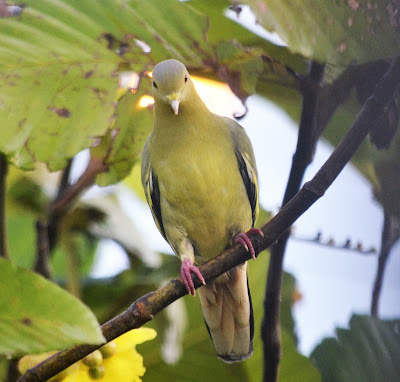 |
| Scarlet-rumped Trogon or "Kesumba Puteri" (Malay) |
Today has been most auspicious. This morning was the first time in my life I encountered a Trogon. It is really an amazing bird, very colourful and quite playful.. It was seen above me (about 3 meters) at Provinsi Rattan, Zone I . In the cool morning atmosphere I heard an unfamiliar call. It sounded like
Kir- rrrr. Within seconds I saw something orange moved infront of me. I remained still and the bird did not seem to be bothered with me. Slowly I took the camera out of the bag and started to aim, before the bird took flight. But no. Surprisingly the bird wanted to 'play' with me. It was moving about the branches above me and that afforded me many angles to shoot the bird. It was gazing at me behind its shoulders and on one occassion turned around facing me straight with its sharp eyes. Trogons are brighly coloured with a short, broad bill. The tails look like as if the feathers were square-cut. It has brown iris, with eyelid of cobalt blue. I noticed its bill was blue. Its head black with a nice orangish red breast. It is a rare bird and is the first time for about more than 10 years staying at the park that I encountered it. What a lifer!.
 |
| The orangish red rump...or 'scarlet-rumped' is plainly seen just as well as the square-cut tail. The bird was seen gazing curiously at me over its shoulders. |
Looking straight at me.

















































